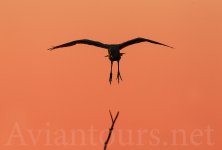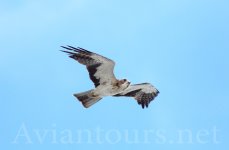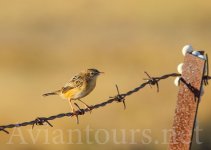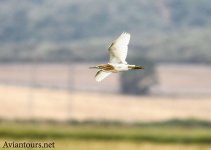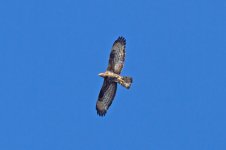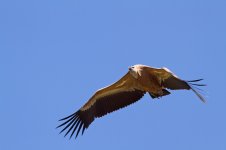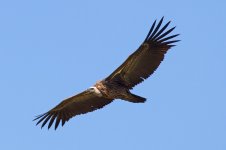Birdman7
Bird photographer
Yesterday I decided to head to the spanish-side of the Straits of Gibraltar to observe bird of prey migration. The winds were blowing quite strong from the east, (approximately force 6 on the beaufort scale). As a result, birds of prey were being forced to accumulate in large numbers relatively close by and offering an incredible spectacle of circling raptors desperately trying to find a way to cross the straits. They couldn't. Birds of all species an ages, composed primarily of Egyptian Vultures (100+), Booted Eagles (200+), Black Kites (150+) Honey Buzzard (50+) with smilers numbers of Griffon Vultures, Montagu’s Harrier, Lesser Kestrel. There was a constant flow of Hirundines, Barn Swallows and San Martins being the main species. Scenes like these provide an ideal scenario for less experienced raptor-watchers to polish their ID skills, particularly, dark morph Booted Eagles and aberrant young Honey Buzzard, flying by at eye-level at some distance. With time and practice it is possible to identify most birds.
I then decided to head to a known Bald Ibis place near Barbate. On the way there via the N340, we spotted large numbers of migrating raptors, primarily black kites, Booted Eagles & Egyptian Vultures. We did however manage to spot an osprey fly low over our vehicle as did 2 young Montagu’s Harriers. Upon arrival at the Bald Ibis location, we were meet by large numbers of Jackdaw resting and calling from the nearby cliffs, but unfortunately, we were not able to locate the Ibis’. We then turned our attention to the Barbate marshes which held large numbers of Yellow-legged Gull and smaller numbers of lesser-black backed Gulls & Black-headed Gulls. We did have however great views on a Stone-Curlew as well as the usual waders, mainly Dunlin, Sanderling, Greenshank, Kentish Plover & Black-winged Stilt. a small group of Short-toed Lark were flying around and at least one individual showing extremely well on our Kowa TSN-883 scope. A distant Collard Pratincole was observed as were Griffon Vultures and Black Kites. On route back to La Janda, a group of 7 Bald Ibis circled by to my delight!
We then turned our attention to La Janda which is an ancient desiccated lake, formerly the home and former breeding ground of Demoiselle Cranes & African Marsh Owls. The last remaining, and most southerly breeding populations of Common Crane dissapeared in the mid 1950′s when La Janda was finally drained. The surrounding area is a breeding ground for rare and endangered Osprey, several species of heron, ibis, crakes and rail, as well as Mallard, deer and other wildlife. La Janda is still under threat from that spices called Homo Sapiens better known as ‘man’. Habitat loss is the main factor affecting La Janda, which is currently being used for extensive agricultre, particularly rice, which thankfully has some sort of positive effect on the bird life as it means large portions of otherwise dry farmland now remains wet for the most part of the year, attracting large numbers of water birds. During the winter months, and depending on the amount of rainfall, it becomes a naturally flooded plain which has through the years, become less conspicuous. I remember in my younger days, after heavy sustained rainfall, the area was transformed into a vast lake several kilometres in length, most of it approximately 6m below sea level. These wonderful sights are now a thing of the past, as improvement in drainage has meant that although the area does temporarily flood up to a certain extent, its nowhere as impressive as it used to be. neverthess, the birdlife is still rich and varied even in the driest and warmest of seasons. Between Benalup and Alcala de Los Gazules a huge dam exists, called the Presa de Barbate. Its purpose was to prevent the fluctuating waters that connected the Marismas de Barbate to La Janda in winter overflowing and flooding La Janda. This presa (reservoir) serves to irrigate the rice fields in summer. The rice is planted in May and harvested from September to November.
At La Janda, large groups of White Stork & a Black Stork sat on the fields, awaiting better conditions in which to cross the straits. Glossy Ibis (50+) sudddenly arrived and joined the Stork group and was a wonderful sight. Flying by where the usual Marsh & Montagu’s Harriers, with several young males of the former seen. Further along, the flooded ricefields, help Black-winged Stilt, more Glossy Ibis, Green Sandpiper, the first few Common Snipe of the autumn (3), Yellow Wagtails and Grey Herons. A solitary Purple Heron made up the numbers. Several groups of Turtle Dove and Jackdaws flew past looking for feeding areas as did a several flocks of Sparrows, which upon inspection, contained at least a single Spanish Sparrow amongst the other House. A definite sign autumn is nigh.
I then decided to head to a known Bald Ibis place near Barbate. On the way there via the N340, we spotted large numbers of migrating raptors, primarily black kites, Booted Eagles & Egyptian Vultures. We did however manage to spot an osprey fly low over our vehicle as did 2 young Montagu’s Harriers. Upon arrival at the Bald Ibis location, we were meet by large numbers of Jackdaw resting and calling from the nearby cliffs, but unfortunately, we were not able to locate the Ibis’. We then turned our attention to the Barbate marshes which held large numbers of Yellow-legged Gull and smaller numbers of lesser-black backed Gulls & Black-headed Gulls. We did have however great views on a Stone-Curlew as well as the usual waders, mainly Dunlin, Sanderling, Greenshank, Kentish Plover & Black-winged Stilt. a small group of Short-toed Lark were flying around and at least one individual showing extremely well on our Kowa TSN-883 scope. A distant Collard Pratincole was observed as were Griffon Vultures and Black Kites. On route back to La Janda, a group of 7 Bald Ibis circled by to my delight!
We then turned our attention to La Janda which is an ancient desiccated lake, formerly the home and former breeding ground of Demoiselle Cranes & African Marsh Owls. The last remaining, and most southerly breeding populations of Common Crane dissapeared in the mid 1950′s when La Janda was finally drained. The surrounding area is a breeding ground for rare and endangered Osprey, several species of heron, ibis, crakes and rail, as well as Mallard, deer and other wildlife. La Janda is still under threat from that spices called Homo Sapiens better known as ‘man’. Habitat loss is the main factor affecting La Janda, which is currently being used for extensive agricultre, particularly rice, which thankfully has some sort of positive effect on the bird life as it means large portions of otherwise dry farmland now remains wet for the most part of the year, attracting large numbers of water birds. During the winter months, and depending on the amount of rainfall, it becomes a naturally flooded plain which has through the years, become less conspicuous. I remember in my younger days, after heavy sustained rainfall, the area was transformed into a vast lake several kilometres in length, most of it approximately 6m below sea level. These wonderful sights are now a thing of the past, as improvement in drainage has meant that although the area does temporarily flood up to a certain extent, its nowhere as impressive as it used to be. neverthess, the birdlife is still rich and varied even in the driest and warmest of seasons. Between Benalup and Alcala de Los Gazules a huge dam exists, called the Presa de Barbate. Its purpose was to prevent the fluctuating waters that connected the Marismas de Barbate to La Janda in winter overflowing and flooding La Janda. This presa (reservoir) serves to irrigate the rice fields in summer. The rice is planted in May and harvested from September to November.
At La Janda, large groups of White Stork & a Black Stork sat on the fields, awaiting better conditions in which to cross the straits. Glossy Ibis (50+) sudddenly arrived and joined the Stork group and was a wonderful sight. Flying by where the usual Marsh & Montagu’s Harriers, with several young males of the former seen. Further along, the flooded ricefields, help Black-winged Stilt, more Glossy Ibis, Green Sandpiper, the first few Common Snipe of the autumn (3), Yellow Wagtails and Grey Herons. A solitary Purple Heron made up the numbers. Several groups of Turtle Dove and Jackdaws flew past looking for feeding areas as did a several flocks of Sparrows, which upon inspection, contained at least a single Spanish Sparrow amongst the other House. A definite sign autumn is nigh.
Attachments
Last edited:




